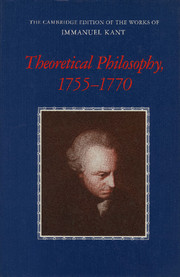Book contents
- Frontmatter
- Contents
- General editors' preface
- Preface
- Guide to abbreviations
- General introduction
- Introductions to the translations
- Résumés of the works
- A NEW ELUCIDATION OF THE FIRST PRINCIPLES OF METAPHYSICAL COGNITION (1755)
- THE EMPLOYMENT IN NATURAL PHILOSOPHY OF METAPHYSICS COMBINED WITH GEOMETRY, OF WHICH SAMPLE I CONTAINS THE PHYSICAL MONADOLOGY (1756)
- AN ATTEMPT AT SOME REFLECTIONS ON OPTIMISM (1759)
- THE FALSE SUBTLETY OF THE FOUR SYLLOGISTIC FIGURES (1762)
- THE ONLY POSSIBLE ARGUMENT IN SUPPORT OF A DEMONSTRATION OF THE EXISTENCE OF GOD (1763)
- ATTEMPT TO INTRODUCE THE CONCEPT OF NEGATIVE MAGNITUDES INTO PHILOSOPHY (1763)
- Preface
- Section 1 Elucidation of the concept of negative magnitudes in general
- Section 2 In which philosophical examples embodying the concept of negative magnitudes are adduced
- Section 3 Containing some reflections which may serve to prepare the application of the above concept to the objects of philosophy
- INQUIRY CONCERNING THE DISTINCTNESS OF THE PRINCIPLES OF NATURAL THEOLOGY AND MORALITY (1764)
- M. IMMANUEL KANT'S ANNOUNCEMENT OF THE PROGRAMME OF HIS LECTURES FOR THE WINTER SEMESTER 1765 — 1766 (1765)
- DREAMS OF A SPIRIT-SEER ELUCIDATED BY DREAMS OF METAPHYSICS (1766)
- CONCERNING THE ULTIMATE GROUND OF THE DIFFERENTIATION OF DIRECTIONS IN SPACE (1768)
- ON THE FORM AND PRINCIPLES OF THE SENSIBLE AND THE INTELLIGIBLE WORLD [INAUGURAL DISSERTATION] (1770)
- Factual notes
- Bibliographies of editions and translations
- Glossary
- Biographical-bibliographical sketches of persons mentioned by Kant
- Index
Section 2 - In which philosophical examples embodying the concept of negative magnitudes are adduced
Published online by Cambridge University Press: 18 December 2014
- Frontmatter
- Contents
- General editors' preface
- Preface
- Guide to abbreviations
- General introduction
- Introductions to the translations
- Résumés of the works
- A NEW ELUCIDATION OF THE FIRST PRINCIPLES OF METAPHYSICAL COGNITION (1755)
- THE EMPLOYMENT IN NATURAL PHILOSOPHY OF METAPHYSICS COMBINED WITH GEOMETRY, OF WHICH SAMPLE I CONTAINS THE PHYSICAL MONADOLOGY (1756)
- AN ATTEMPT AT SOME REFLECTIONS ON OPTIMISM (1759)
- THE FALSE SUBTLETY OF THE FOUR SYLLOGISTIC FIGURES (1762)
- THE ONLY POSSIBLE ARGUMENT IN SUPPORT OF A DEMONSTRATION OF THE EXISTENCE OF GOD (1763)
- ATTEMPT TO INTRODUCE THE CONCEPT OF NEGATIVE MAGNITUDES INTO PHILOSOPHY (1763)
- Preface
- Section 1 Elucidation of the concept of negative magnitudes in general
- Section 2 In which philosophical examples embodying the concept of negative magnitudes are adduced
- Section 3 Containing some reflections which may serve to prepare the application of the above concept to the objects of philosophy
- INQUIRY CONCERNING THE DISTINCTNESS OF THE PRINCIPLES OF NATURAL THEOLOGY AND MORALITY (1764)
- M. IMMANUEL KANT'S ANNOUNCEMENT OF THE PROGRAMME OF HIS LECTURES FOR THE WINTER SEMESTER 1765 — 1766 (1765)
- DREAMS OF A SPIRIT-SEER ELUCIDATED BY DREAMS OF METAPHYSICS (1766)
- CONCERNING THE ULTIMATE GROUND OF THE DIFFERENTIATION OF DIRECTIONS IN SPACE (1768)
- ON THE FORM AND PRINCIPLES OF THE SENSIBLE AND THE INTELLIGIBLE WORLD [INAUGURAL DISSERTATION] (1770)
- Factual notes
- Bibliographies of editions and translations
- Glossary
- Biographical-bibliographical sketches of persons mentioned by Kant
- Index
Summary
1. A body, in virtue of its impenetrability, resists the motive force of another body attempting to penetrate the space which it occupies. In spite of the motive force of the second body, the impenetrability of the first body is nonetheless a ground of that second body's rest. It follows from what has already been said that impenetrability just as much presupposes a true force in the parts of me body, in virtue of which they collectively occupy a space, as does the force in virtue of which another body strives to enter this space.
By way of elucidation, imagine two springs which are opposed to each other. Without any doubt they maintain each other in a state of rest by means of forces which are equal to each other. Place between the two a spring of the same elasticity; this spring, by its effort, will produce the same effect, and, in accordance with the rule of the equality of action and reaction, it will maintain the two springs in a state of rest. On the other hand, if this spring is replaced by a solid body which is put between the other two springs, the same effect will be produced: the impenetrability of the solid body will maintain the aforementioned springs in a state of rest. The cause of impenetrability is thus a true force, for it produces the same effect as a true force. Now, if you call attraction a cause, of any kind you please, in virtue of which one body constrains other bodies to press upon the space which it itself occupies or to set it in motion (though here it is sufficient simply to think of this attraction), then impenetrability is a negative attraction. This serves to show that impenetrability is as much a positive ground as any other motive force in nature.
- Type
- Chapter
- Information
- Theoretical Philosophy, 1755–1770 , pp. 218 - 226Publisher: Cambridge University PressPrint publication year: 1992
- 1
- Cited by



